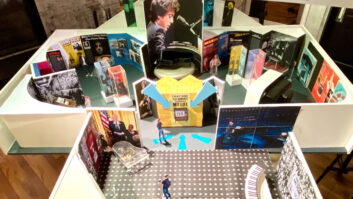Elton John and Billy Joel, two of the most successful singer/songwriters of the past three decades, are touring together for the fourth time. Performing a marathon set that lasts almost four hours, the two piano men work their way through 36 songs, including familiar hits and audience favorites, plus several songs on which each artist sings the other’s composition. Mix caught up with the Face 2 Face tour during a three-night stint in the San Francisco Bay Area January 31 through February 4. (Photos are from the Arco Arena in Sacramento, the Oakland Arena and the San Jose Arena.)
Billy Joel’s drummer Liberty Devitto and saxophone/vocal/guitarist Mark Rivera are using in-ear monitors. According to FOH engineer Ruggles, the IEMs are a great improvement. “They’ve commented that they are hearing things they never heard before — it’s great,” he notes.
Clive Franks (far right) has been Elton John’s FOH engineer for the past 27 years. The three FOH consoles are all Yamaha PM4000s. “I use about 32 mic inputs, but about 12 of those are stereo, so we have about 50 lines of microphones,” says Franks. “I’ve got two 4Ks,” explains Billy Joel’s FOH engineer Brian Ruggles. “Half of the second one is used for Liberty Devitto’s drums and Crystal Taliefero on percussion.” The remaining half 4K is used as the main P.A. drive board, with the other two boards feeding into it.
For this tour, the Clair Bros. S-4 system that both Franks and Ruggles have been using for years has been replaced with Clair’s I-4 line array P.A. “It’s a lot smaller, it’s also a lot tighter-sounding,” says Franks of the I-4 system. “The clarity is phenomenal — a crisp, more focused, even sound.
Billy Joel’s monitor engineer Mike Pirich (left) and Elton John’s monitor engineer Alan Richardson
Both Elton John and Billy Joel have their own monitor engineers, each using a Yamaha PM4000M. When both bands are onstage together, the monitor engineers provide each other with splits and submixes. “Both Alan and I are sending mixes back and forth for part of the show,” explains Pirich. “We have direct splits of Billy and Elton’s vocal and piano signals, and we create a rhythm mix and a background vocal mix. So, for instance, Billy is able to hear Nigel [Elton’s drummer] when Liberty isn’t up there.” Joel actually controls the levels of his own monitors via a 2-channel passive attenuator patched across piano and overall band mix sends.
Pirich is using TC Electronic and Yamaha reverbs, with dbx 903 and Summit TLA-100 compressor models. Most of the Joel band is miked with Audio-Technica microphones, including the new 7373 wireless, 4054s for all hard-wired vocal channels and 4050s on drum overheads.
All the vocal mics for Elton John’s set are Shure Beta 58As. Drummer Nigel Olsson has AKG D-112s on his kick, Sennheisers on the toms and Shure 57s on almost everything else. “We’re trying out some B.L.U.E. mics for overheads, and our percussionist John Mahon is using them,” notes Richardson, whose effects rack features Yamaha SPX-1000s, which he uses for reverbs for Elton and the two bandmembers using in-ear monitors. Richardson also uses dbx 160 limiters and Aphex gates. Limiters for the Shure in-ear wireless system are by Klark Teknik.
“For Billy’s vocal, I use an Audio-Technica 4054 mic, which I find sounds great with his voice,” says Joel’s FOH engineer Brian Ruggles. For reverb on Joel’s voice, Ruggles uses the TC Electronic M5000. “I also use the TC2290, a PCM-70 for background vocals, and some SPX990s and 1000s for other effects on drums and other instruments,” Ruggles explains. “I don’t get too crazy with outboard gear, I keep it simple.” Joel’s lead vocal is patched through a Manley compressor, and Ruggles also uses Summit compressors and Aphex gates for dynamic control.
Elton John sings into a Shure Beta 58. “The fact that he’s right on the mic helps me with separation,” says FOH engineer Franks. “But no matter how close he gets to the mic, because his monitors are so loud and he likes a lot of effects, harmonizers and reverb in his monitors, I hear [the effects] picking up in the mic, which means I’m not able to use my effects as much.”







